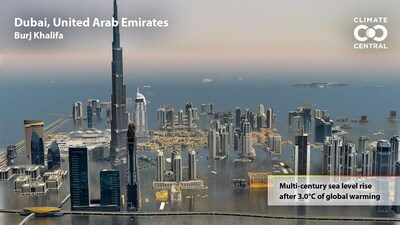Source prnewswire
Visualized sea level projections reveal risks for U.N. Climate Change Conference host cities as temperatures rise
Based on different scenarios for global warming, Climate Central released a new visualization today comparing projected sea levels at iconic sites. Based on a localized analysis of well-known areas of Dubai and other United Nations Climate Change Conference (COP) host cities, it can be assumed that these areas will remain above sea level if global warming is halted at 1.5 Celsius degrees over pre-industrial temperatures, but they will fall below the high tide line if global warming reaches 3.0 degrees. As a result of Climate Central's visual analyses of the hosts of COP 18 and COP 20, local landmarks remain above sea level if global warming is limited, but fall below the high tide line if global warming exceeds set thresholds, with Doha, Qatar (2012) and Lima, Peru (2014) showing similar dependencies.. As a result of global warming, Casablanca, Morocco and Jakarta, Indonesia - countries that have hosted previous UN climate conferences - also show diverging futures based on global temperatures.. Climate Central's Picturing Our Future digital library now includes visualizations for these cities that can be viewed online Climate Central's Picturing Our Future digital library now includes visualizations for these cities that can be viewed onlineCOP 18 host Doha, Qatar (2012) and COP 20 host Lima, Peru (2014) show similar dependences in Climate Central's visual analysis, with local landmarks remaining above sea level if global warming is kept to a minimum, but falling below the high tide line if temperatures rise above set thresholds.. Casablanca, Morocco, and Jakarta, Indonesia - two countries that have hosted past COPs - also show diverging futures as a result of the global warming trend. There is now a digital library available for climate Central's Picturing Our Future that contains visualizations for these cities There is now a digital library available for climate Central's Picturing Our Future that contains visualizations for these citiesClimate Central CEO and Chief Scientist, Dr. Benjamin Strauss, said that decisions made at COP 28 will affect the future of Earth's coastal cities, including Dubai, in the long run. The survival of these places and their heritage will be dependent on whether government and industry leaders can agree to cut carbon pollution sharply enough and rapidly enough to limit global warming to 1.5 Celsius degrees.In addition to Glasgow, Scotland (2021), Durban, South Africa (2011), Copenhagen, Denmark (2009), The Hague, Netherlands (2000), and Buenos Aires (1998), Picturing Our Future also features other host cities for the United Nations Climate Change Conference. The comparisons of more than 100 sites in 40 countries across multiple warming scenarios are freely available at picturing.climatecentral.org for media, educational, and non-commercial use.The analysis beneath Picturing Our Future visualizations is based on peer-reviewed sea level rise projections and localized land heights from Climate Central's digital elevation model, CoastalDEM, which uses peer-reviewed data.. Sea levels associated with various levels of sustained warming can be projected with relative certainty, however the time it may take for sea levels to reach those levels is dependent on a variety of complex factors that affect sea levels in the future. Sea levels are likely to rise in the coming centuries as visualized in Picturing Our Future. Detailed descriptions of the methodology are included in the peer-reviewed paper, "Unprecedented Threats to Cities from Multi-century Sea Level Rise," published in the journal Environmental Research Letters in 2021. Detailed descriptions of the methodology are included in the peer-reviewed paper, "Unprecedented Threats to Cities from Multi-century Sea Level Rise," published in the journal Environmental Research Letters in 2021.In addition, this methodology supports multi-century coastal maps from Climate Central (https://coastal.climatecentral.org/map/?theme=warming&map_type=multicentury_slr_comparison) which compare future coastlines based on different global warming scenarios.Climate Central can be contacted via Peter Girard, vice president of communications, at [email protected] or by calling 609-986-1999Climate Central: What we do and why it's importantFounded in 1998, Climate Central is a non-profit science and news organization that provides authoritative information to help the public and policymakers make informed decisions about climate and energy. It is a non-advocacy, non-profit organization.Climate Central is the source of this informationThere has been a new 12-month record set in global temperatures, with temperatures exceeding 1.3 degrees Celsius above pre-industrial levels from November 2022 through October 2023,...The influence of climate change on global temperatures was attributed to all 180 countries and 22 territories in a Climate Central attribution analysis of global temperatures...If you would like to receive PRN's top stories and curated news delivered directly to your inbox every week, sign up today!


No Comments